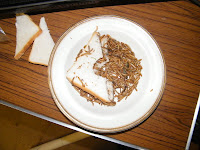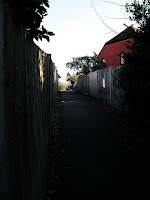

To begin our filming for this term, and try out some methods/ideas for shots we had, we decided to have a film shoot during half term at the Southborough scout hut. After some deliberation, we decided to try out three of our trickiest shots - a smashing glass, our main character eating a sandwich filled with worms, and our studio lighting shots which we were able to achieve using the space that the scout hut gave us.
 The first shot we tried was the 'worm sandwich' shot. We were able to purchase live mealworms from the pet shop a couple of minutes walk away, which made for nice closeup shots of the sandwich we created. In order to shoot Harri eating it, we made a bitemark shape around which we made sure there were no worms, then shot him pretending to eat the sandwich. Overall, the close-ups of the sandwich looked brilliant, but the shot of him eating it was under-lit - we might try it again, if Harri's up for it. We did attempt some other shots with the worms, where we let one wriggle around on Harri's face and then shot a close-up. This also worked well, and we plan to use it and the others in our final edit.
The first shot we tried was the 'worm sandwich' shot. We were able to purchase live mealworms from the pet shop a couple of minutes walk away, which made for nice closeup shots of the sandwich we created. In order to shoot Harri eating it, we made a bitemark shape around which we made sure there were no worms, then shot him pretending to eat the sandwich. Overall, the close-ups of the sandwich looked brilliant, but the shot of him eating it was under-lit - we might try it again, if Harri's up for it. We did attempt some other shots with the worms, where we let one wriggle around on Harri's face and then shot a close-up. This also worked well, and we plan to use it and the others in our final edit.
As well as this, we attempted to shoot our 'pouring vodka' shot, in which the character's alter-ego takes a bottle of vodka (water for the purposes of the shoot) and tips it in progressively increasing quantities over his face and body, to be juxtaposed with him quietly and subduedly drinking a cup of tea (or otherwise). This went extremely well in my opinion, as Harri acted the part convincingly and was able to achieve exactly the look we were going for.
All the shots we tried with different lighting haven't been reviewed yet, but we are confident that they will look good.
The final shot we tried, and the one that didn't go as well, was the 'smashing glass' shot. The problem was that the camera we were using did not have a fast enough framerate to capture the glass's fall. We ended up with about one frame of a blurred object and then the smash at the end. We may have to reconsider this shot, or else find a way of filming it with different equipment.
Overall, we had a good day's worth of filming, only ended because of the poor weather stopping us from completing our outdoor shots. Everything we achieved on that day will help us to continue to work on our project, and inform us toward future shoots.











































